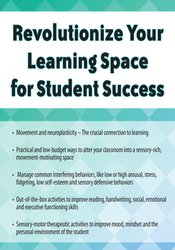Description
Justin Lyons – Revolutionize Your Learning Space for Student Success
- Faculty:
- Justin Lyons
- Duration:
- 6 Hours 43 Minutes
- Format:
- Audio and Video
- Copyright:
- Dec 06, 2019
Description
What does the physical and emotional climate of your classroom look like?
Do your students complain about being tired? Is it hard for them to sit-up straight after hours of seated instruction? Is there enough clutter in the classroom to cause a panic attack? Does daydreaming and fidgeting replace attentive and ready-to-learn behaviors?
Watch this recording to assess the state of your school today and the different environments of learning to better address the needs of students.
You’ll earn how neuroplasticity, our sensory system and ergonomics work together to advance learning and academic success! You’ll discover how universal design concepts, in both learning and architecture, will foster the right educational climate for all students!
Then we dive right into:
- Managing common interfering behaviors, like low or high arousal, fidgeting, low self-esteem and sensory defensive behaviors
- Tons of out-of-the-box movement and sensory-based activities/strategies to improve reading, handwriting, social, emotional and executive functioning skills
- Handouts and checklists to assess your various school environments
- Practical, low-budget ways to alter your classroom into a sensory-rich, movement-motivating space to support learning, self-regulation and personal health and wellness
- Tackling stress, under-aroused or dysregulated behaviors in students through mindfulness
- Using the power of language and other sensory-motor therapeutic activities to improve mood, mindset and the personal environment of the student
Finish this program feeling confident in your ability to create neuro-friendly spaces to meet the academic and emotional needs of your students.
Handouts
| Manual – Revolutionize Your Learning Space for Student Success (17.6 MB) | 147 Pages | Available after Purchase |
| Extra Handout (764.9 KB) | 6 Pages | Available after Purchase |
| Instructions for ASHA Credit – SELF STUDY ONLY – 12/06/19 (38.5 KB) | Available after Purchase |
Outline
Assess the State of Your School Environment Today
- Defining the environments of learning
- Movement and neuroplasticity – identify the crucial connection to learning
- Technology in the schools – the pros and cons
- Universal Design and ergonomics in the classroom
- Surveying the workspace/class space – Checklists and handouts
Setting the Stage to Optimize a Multi-Sensory Experience
- Video demonstration and Learning Lab
- Recognizing the 8 senses in action
- Real-time assessment of the classroom
- Impact of technology
- Stressors of learning
STRATEGIES AND THE “HOW-TO”
Ergonomic Solutions for Optimal Learning Environments
- Simple DIY tricks for the classroom
- Seating solutions – tall vs. short, wiggle seats, and more!
- Reduce clutter and other classroom organization hacks
- Classroom design ideas that promote executive functioning skills
- How to incorporate light and color to promote learning
- The “20/20/20 Rule” and other ergonomic tips for better endurance and attention
- ”Common scents” – aromatherapy pointers for the class or student
”Get Moving”: Strategies to Support Active Bodies in the Classroom
- ”No need to interrupt instruction time”
- Put the hands back into “hands-on” learning – leave the computer out of this!
- ”Go-to exercises” for the whole classroom to:
- Preserve health and wellness
- Incorporate fun into the day
- Increase endurance and efficiency
- Foster movement and reduce dysregulation
- And more!
Sensory-Motor Techniques to Improve Classroom Skills: Hands-on Lab
- Multisensory approach for skill retention
- Proprioceptive strategies – letter recognition, formation, sizing and spacing
- Vestibular and visual connection – reading and note-taking outcomes
- Sensory suggestions – executive functioning skills (alerts and visual reminders)
- Sensory-based tools to get students engaged – gum chewing, mini-sensory stations and therapy balls …
- Visual-motor games and strategies – vision-based school tasks
- Group activities to build social learning skills and classroom connection
- Low-tech strategies (you don’t need an app for everything!)
Redesigning the Emotional Culture of the Class: What is the Language of Your Classroom
- Fostering a “growth mindset”
- Breathing and muscle relaxation techniques
- Address the stress: “Go-to” mindfulness activities and guided imagery
- Language hints and tricks to manage challenging behaviors
Faculty
Justin Lyons, MS, OTR/L Related seminars and products: 1
Justin Lyons, MS OTR/L, has had over a decade of experience working with children of all ages and all abilities, in school, home, camp and community settings. As an occupational therapist, he has served a multitude of pediatric populations, especially the learning disabled, emotionally disturbed and autistic spectrum populations. He currently works at a premiere special needs school in NYC, where he developed a life-coaching program for pre-teens and teens.
Justin has been a presenter at the AOTA conference and both an adjunct professor and guest lecturer for a Master’s occupational therapy program. Justin mentors other aspiring occupational therapists, by encouraging evidence-based practice and compassion for the human experience. He has provided seminars in the community to help parents and students understand the brain and the senses. He has provided services as an expert witness in child occupational performance in a school setting. Justin has practiced as a certified Irlen screener.
Speaker Disclosures:
Financial: Justin Lyons has an employment relationship with The Summit School. He is the founder and owner of Special Connects LLC. Mr. Lyons receives a speaking honorarium from PESI, Inc.
Non-financial: Justin Lyons is a member of the American Occupational Therapy Association.







Reviews
There are no reviews yet.